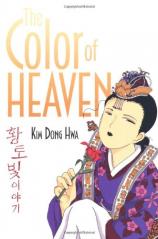The Color of Heaven
Review
The Color of Heaven
After discovering that his boss was trying to buy Ewha’s hand in marriage and then retaliating against the old man on his dearly beloved’s behalf, the farmer’s assistant Duksam is going to have to flee town. He shows up late at night in the inn, angry men hot on his tail, and tells Ewha that he plans to travel to Mokpo and make his fortune as a sailor. When he has enough money to support Ewha as his wife, he will return for her.
But in the meantime, she will have to become like her mother—and wait at home for the one she loves, constantly looking toward the entrance to town in the hopes that her man will be walking through the gate toward her. Much of The Color of Heaven, the third and final volume of Kim Dong Hwa’s path-breaking Colors Trilogy, documents this bittersweet waiting game. Mother and daughter spend many a break during the busy day and respite during the quiet night ruminating and expounding upon their desires and the nature of the male portion of the species.
It can get a bit tiresome in places; take this manhwa literally and you might assume that the only thing women talk about amongst each other is men. While this is a perspective of the world that flatters the male ego, it has no relationship to reality. However, inasmuch as the setting, pre-industrialized, agrarian Korea, was intensely patriarchal, the nostalgic, pseudo-poetic way in which mother and daughter discuss human relationships does indirectly explicate the ways in which social selfhood are conferred only upon women who are attached to a man, either as daughter or wife.
Furthermore, those with interest in Korean culture will appreciate the final portions of The Color of Heaven. Duksam does, needless to say, return to Ewha, and their marriage ceremony—not to mention their first conjugal night together—is depicted in languid, loving detail. Though quite frank in its sexuality, it is not pornographic, and the suggestive visual metaphors, such as a mortar and pestle, for example, used by Kim at the end of the book is reminiscent of a less permissive era of Japanese manga.
One of the keenest pleasures of this book, as with the previous two volumes, is its exquisitely beautiful artwork. Pitch-perfect traditional style and content merge seamlessly with the modern conventions of sequential art storytelling. It’s like a Korean costume drama in two-dimensions…save that costume dramas on television typically depict the lives of the privileged, while the protagonist of the Colors Trilogy is a girl of very modest means and ambitions. Nevertheless, the wedding ceremony with its traditional dress is glorious, and much improved image reproduction in this First Second edition means that it can be enjoyed without distraction.
The Color of Heaven is without peer in the English language graphic novel market. Nowhere else is there such a sustained view of Korean tradition and agrarian life. For its uniqueness alone, it is a must read, and for the magnitude of its achievement, it is unforgettable. Highly recommended.
Reviewed by Casey Brienza on September 1, 2009
The Color of Heaven
- Publication Date: September 1, 2009
- Genres: Graphic Novel
- Paperback: 320 pages
- Publisher: First Second
- ISBN-10: 1596434600
- ISBN-13: 9781596434608



